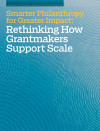SUPPLEMENT TO SSIR SPONSORED BY GRANTMAKERS FOR EFFECTIVE ORGANIZATIONS
Smarter Philanthropy for Greater Impact

This special supplement includes eleven perspectives on “scaling what works”—what it means, what it takes to do it right, and what needs to happen to increase the impact of successful solutions to social challenges.
-
What Would It Take?
-
Emerging Pathways to Transformative Scale
-
Pathways to Scale for a Place-Based Funder
-
The Road to Scale Runs Through Public Systems
-
From Innovation to Results
-
Perspectives on the Social Innovation Fund
-
Partners in Impact
-
We Need More Scale, Not More Innovation
-
More Resources, More Co-Investors, More Impact
-
In Collaboration, Actions Speak Louder than Words
-
Leveraging a Movement Moment
Michael Smith was named director of the US government’s Social Innovation Fund (SIF) in July 2013 after serving as senior vice president for social innovation with the Jean and Steve Case Foundation. In this conversation, he reflects on the SIF’s efforts to expand the impact of innovative and successful solutions to community challenges across the country, and on what lessons philanthropists can learn from those efforts.
What do you bring from the world of private philanthropy to the SIF? At the Case Foundation, I was working for entrepreneurs, supporting entrepreneurs, and helping to build social enterprises. That experience convinced me that every sector brings something to the table. Government is less agile than business and philanthropy but is unmatched in reach and potential scale. The nonprofit sector brings grassroots credibility, deep knowledge of the issues and communities, and the networks that provide the collective brainpower and the reach to make solutions possible. Philanthropy contributes the risk capital that’s critical for piloting innovative programs and often serves as a connecting point across sectors. The private sector acts quickly to make promising investments. The business world also brings expertise with return on investment, an appreciation of markets and market forces, and continuity through shifts in national priorities, leadership transitions, and political stalemates. Blending together the best of each sector will undoubtedly present occasional disagreements, as in any relationship, but it will yield stronger solutions in the end.
The SIF supports and helps to scale up community programs that have proven to have impact. How can you balance the focus on proven concepts with finding “hidden-gem” solutions that might not be getting the attention they deserve? The SIF is built on four interdependent pillars that distinguish it from other programs and that make it vital to the social sector and the nation: innovation, evidence, scale, and cross-sector partnerships. We seek to lift up innovative solutions that counterbalance ineffective programs. We want to identify evidence-based approaches in a field that too often measures success by numbers served or by isolated stories. By scalable solutions, we mean ones that can be replicated nationwide. And our focus on cross-sector partnerships rooted in grantmaker intermediaries ensures that the work is citizen-centered and that these initiatives can grow and take hold at the local level even after SIF dollars are gone.
The SIF’s biggest contribution will be a cornucopia of tested, replicable solutions and lessons about what works, what doesn’t, and why. We view ourselves as a robust deal pipeline and solutions laboratory for a diverse array of funders. But there is an inherent tension in trying to lift up and invest in solutions that are both new and evidence-based. Reducing that tension is not easy, but it is our mandate. My goal is to create a diversified SIF portfolio in the same way you would create a balanced retirement account—allocating investments to a mix of high-performing solutions with high levels of evidence as well as more innovative, perhaps more nascent, solutions that show early evidence of being game changers and can be evaluated more rigorously.
What most excites you about what you hear from the institutions that are receiving SIF funds? I am absolutely knocked off my feet by the level of rigor in measuring impact that I see in SIF-funded programs. Eighty-six interventions are being tested through high-quality evaluation models—from quasi-experimental designs to randomized control trials. This fidelity to evaluation won’t just benefit their organization, it will provide tremendous benefit to the entire social sector. Whether it’s determining how to keep HIV patients in treatment or how sports can help disconnected youths find a path to success, what the SIF-funded efforts are learning has the potential to transform service delivery and change lives far beyond the boundaries of our grant recipients.
If the field of philanthropy could change on the basis of what SIF is learning about growing impact, what would those be? It is critical for the funding community to accept that not all of our grantees are “above average.” I recommend that funders who are interested in building evidence-based interventions keep three things in mind.
First, we need to ask What are the results? Long before we bring in a third-party evaluator, funders and nonprofits should work together to define their intervention, determine expected impacts, implement systems to capture data, and commit to reviewing outcomes and making course corrections at regular intervals. The second thing to remember is that evaluation should be about proving and improving. Evaluation results should represent the beginning of a process where all stakeholders use what is learned to enhance and even overhaul programs. The third consideration is the toughest: how to stop capital from flowing to programs that aren’t demonstrating good results, and, in some cases, are doing harm. These programs often continue to be funded by well-meaning program officers or government appropriators to the detriment of our communities, and also to the detriment of effective organizations competing for scarce dollars. We can’t continue operating in this way. We have to be willing to say no, suggest mergers, and most important, demand results.
Support SSIR’s coverage of cross-sector solutions to global challenges.
Help us further the reach of innovative ideas. Donate today.
Read more stories by Grantmakers for Effective Organizations.

